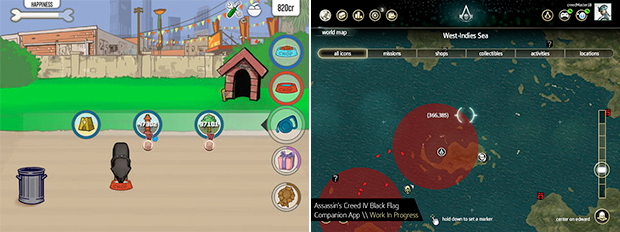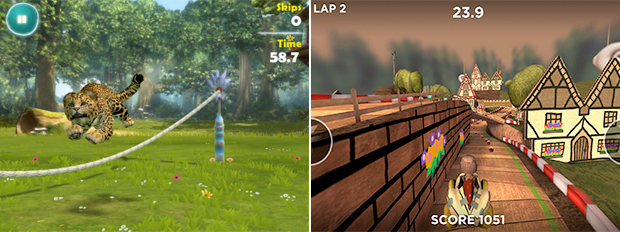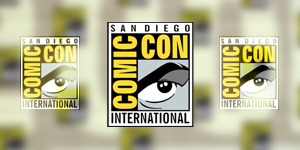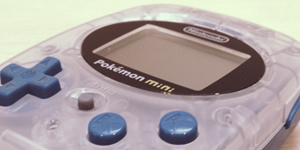Extra: Nintendo’s Mobile Calling
It’s been the battle cry of analysts since Nintendo’s profits started to decline: go mobile. They argue that with a simple push of Nintendo’s biggest franchises onto the App Store and Google Play, all the company’s financial woes will be over. Except for the fact that, well, it isn’t quite so simple. Numerous articles have highlighted the issues of fully diving into the mobile space, including the mismatch of Nintendo’s polished experiences with the free-to-play model and poor virtual controls being shoehorned into retro game ports that don’t even sell well. Yet with hundreds of millions of smart devices on the market, there’s no denying this is an important area for Nintendo to explore. And Satoru Iwata, Nintendo’s global president, knows it. Speaking with investors last week, he explained that the company must leverage mobile for “achieving greater ties with our consumers… and expanding our platform business.” The problem? Nintendo’s not sure how to do it. They want an app, but they have not yet figured out a central hook, with Iwata even admitting that “ensuring continued engagement is going to be challenging.” Luckily for them, other video game companies have forged a path for successful adaptation of mobile. Here’s a look at three ways Nintendo can smartly use smart devices.
Companion Apps
Up until this past year, console games were limited to just that: a console. Going to work or school meant disconnecting from your current gaming obsession. That’s now changing as more companies embrace the idea of companion apps, which let players continue to interact with the game’s world no matter where they are. For Grand Theft Auto 5, Rockstar Games released the iFruit app, which let players both train the game’s virtual dog and customize their car. Both resulted in immediate benefits in the main game: training the dog meant he was more responsive and would find hidden items, while handling car customization on the go meant your tricked out ride was waiting for you when you next booted up the game. Similarly, Assassin’s Creed IV: Black Flag received its own companion app let players check in on their pirate ship fleet in real-time and allowed for repairs to be made as needed. Ubisoft isn’t stopping there, though. This year’s Watch Dogs will come with its own companion app that will let players hack the city of a console player.

The appeal of such companion apps is two fold. For players, it allows them to continue playing their games even when not sitting in front of their consoles. For companies, it builds more awareness about their product and acts as a marketing tool. When the iFruit app was released, for example, it was heavily promoted across the App Store and was a Top 10 download for weeks. This is extra publicity that reaches an audience who may not necessarily know the latest game industry releases or news. It’s a perfect fit for Nintendo, especially since they already do similar experiences through the Pokemon Global Link. First introduced with Pokemon Black & White, this website fully integrates with the Pokemon games and provides options to earn additional in-game items, view battle logs, and more. Expanding such experiences into a mobile app seems like a logical next step.
Side Games
Going one step further than a companion app are mobile-exclusive side games that expand the game worlds we’re already familiar with. Microsoft notably tried concept with the release of Kinectimals for iOS and Halo: Spartan Assault for Windows Phone. Both games provided players with original experiences, yet each took an entirely different approach. Kinectimals essentially mimicked the gameplay of the Xbox 360 title, but featured five exclusive breeds that were unlocked in the main Xbox game once you raised them in the iOS version. Halo: Spartan Assault, on the other hand, went with a mobile-friendly gameplay scheme that replaced first-person shooting with a third-person perspective and provided new insights into Halo lore. Other companies have made similar moves on mobile devices. To promote PlayStation Battle All-Stars in Japan and Europe, Sony released a free minigame compilation on iOS and Android that featured many of the same characters and environments, but entirely different gameplay. Ubisoft, meanwhile, found huge success by taking the core gameplay of Rayman and combining it with the mobile-friendly endless runner genre to create Rayman: Jungle Run and its sequel, Fiesta Run. Much like companion apps, these entirely new games help to raise awareness. When the games are well made, they build up good will for the brands and can expose these franchises to entirely new audiences.

Side games will definitely take the most effort on Nintendo’s part, but they have done them before – on the web. The Pokemon Global Link once again proved to be a testing ground for such experiences. In its Pokemon Black & White 2 iteration, the website included a free game called Pokemon Dream World, in which players befriended Pokemon on a special island, participated in minigames, and earned items that could be sent back to the main Black & White 2. It was a full-fledged standalone experience that tied in with the core Pokemon games in a unique way. If Nintendo were to attempt such an idea on mobile, it could work incredibly well. Imagine if the already-touched-controlled Captain Toad levels from Super Mario 3D World were their own standalone experience on mobile that unlocked extras in a full Mario game. It would provide a fun experience for mobile audiences while also giving just a taste of what a true Mario game can contain.
Functional Apps
Games may be fun and all, but good gaming apps often serve a functional purpose, too. Sony’s official PlayStation app lets you message friends, view who’s online, watch livestreams, and remotely purchase game downloads. Microsoft’s official Xbox app does much of the same, as well as provides its SmartGlass second-screen experience. Even Valve has a similar app for Steam. Individual games get in on the functionality as well. Halo and Call of Duty both feature apps dedicated to stat-tracking, clan information, and other vital online information. At this point, such apps are not as much about promoting a brand as they are about providing a well-rounded experience. While creating companion apps or side games may help to enhance a game’s profile or overall experience, apps for stat tracking and communication are now such commonplace that not having one can hurt a brand. Think of it like the Internet: at a certain point, it became detrimental for a company to not have a website.

Luckily, this is the one type of app Nintendo has already committed to making. During last week’s investor meeting, Iwata explained that the currently planned app will provide news and link to users’ Nintendo Network IDs to allow for remote eShop downloads. Previously, Nintendo also confirmed plans to create a native Miiverse app, which will presumably be rolled into this universal one. It’s also worth nothing that Nintendo does offer a mobile site for Miiverse that mimics much of the functionality and design of a well-made app. If Nintendo sticks to this paradigm while fleshing out functionality, it will be a good starting point for their push into the mobile space.
What Will Nintendo Do?
It’s an interesting time for the game industry as companies juggle premium console experiences with mobile ones, resulting in new gameplay through companion apps and side games. Nintendo has already confirmed it will use smart devices on a functional level as a platform for news and communication between fans. Beyond that, however, is anyone’s guess. The mobile team at Nintendo has been given complete freedom and Iwata has stated he is “not ruling out the possibility of making games or using our game characters.” Perhaps Nintendo’s mobile push will take the shape of a companion app for Animal Crossing, allowing you to check in on mayoral duties from your smartphone. Or perhaps it will be a full side game in which you complete minigames as Kirby to unlock bonus stages in his next adventure. Whatever it ends up being, we’ll be connecting with Nintendo in exciting new ways very soon.




Great insight into Nintendo’s mobile options!